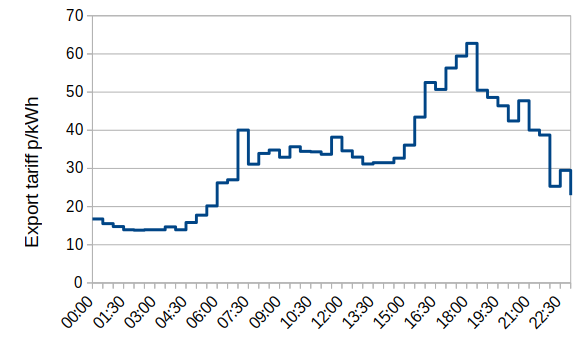On the 19th July 2022, the UK saw a record high temperature set of 40.3°C. In one way, the previous day was more interesting - the electricity grid was nearly unable to match demand. The grid operators were predicting a 70% chance of electricity demand exceeding supply which would then cause blackouts. It's really worth taking a look at the demand curve at that link, it shows how close we were to bad things happening.
A few weeks back, we finally managed to get an export tariff sorted for our solar panels. We're on Octopus Agile Outgoing (that's my referral link). Most export tariffs these days pay something like 5.5p - 7.5p per kWh, which isn't that great when you're paying maybe 27p/kWh to import electricity. Agile Outgoing, by contrast, pays a variable rate which changes every half hour, with the rates published a day in advance at around 4pm. I've only got less than a month of experience so far, but in that time the price per kWh has always been much closer to the import rate.
This is a real consideration if you're concerned about the "financial performance" of your panels. If you're exporting for around the same price as it costs you to import, then there is no real difference as to whether you use the generated electricity yourself, or export it. If it's sunny then it's really rather hard to make use of all of the electricity being generated, so you're going to be exporting - making 5.5p/kWh or 20p/kWh is a big gap.
From what I've seen, there is a fairly typical curve with a peak at around 5-7pm when lots of people are cooking their tea etc. Octopus publish the history of the tariff, so I could go back and look how it has performed and whether it is typical - but I reckon these are unusual times. Either way, that time period isn't great for solar generation.
Back to the 18th, the export rate is shown below.

There is a half hour period there giving an export rate of around 62p/kWh - or more than double import rates, and it's at more than 50p/kWh for three hours, which is still very nearly double. Yowzers! It certainly worked as an incentive for me, I switched our battery to manual export for the first time ever and drained as much as I could (it has a maximum discharge rate of 2.6kW). I hope I contributed to the health of the electricity network in a small way.
We received our first export statement, covering a period of 18 days. In those 18 days we generated a total of 356kWh with an average export rate of 23p/kWh, for a total of £82. Not bad! If we'd been on a more typical 5.5p/kWh export rate we would've got £20.
We also get a full 30 minute breakdown of exports (in a 21 page pdf), and day by day totals. My worst day was £0.07 and the best day was the 18th July at a mega £10.88. The manual export from the battery accounted for about £2.60 of that. That paid off more than 0.1% of the cost in just one rather exceptional day.
I'm looking forward to getting longer term data so I can get a better idea of how things are going to work out. I am concerned about whether getting solar panels was a good idea from a financial point of view - it looks like the answer is a big yes - but sustainability is a greater concern for me. I'm presenting this post to give others a better idea of the potential financial outcomes.